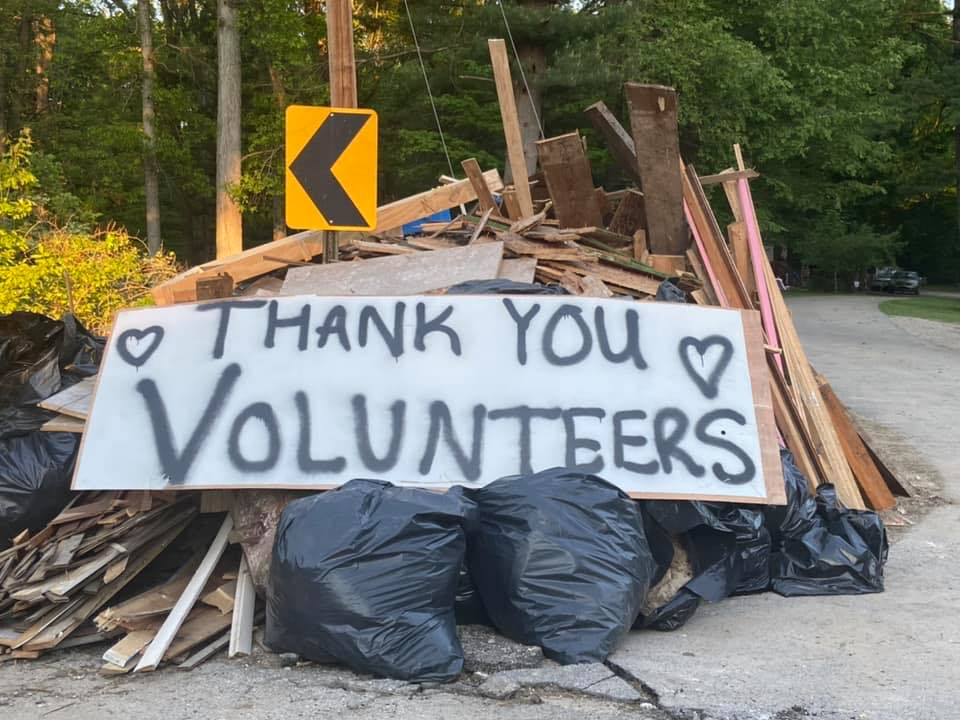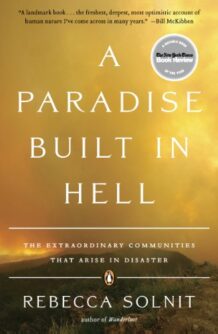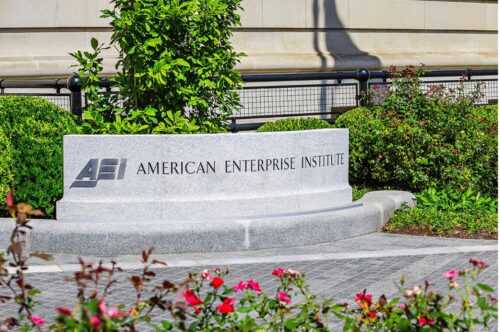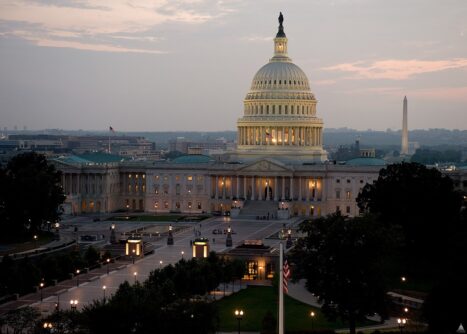As shown in and by Sanford, Mich., starting one year ago, it’s often when massive devastation is visited on a population that it discovers its true character.
One year ago this week, the Tittabawassee River dam in Edenville, Mich., failed during a steady, heavy rain. The break drained Wixom Lake, water from which then poured into Sanford Lake—overwhelming the dam in Sanford, Mich. Floods ravaged the area.
In the wake of the disaster, as local businesswoman Connie Methner told Detroit’s WXYZ earlier this week, “Everybody helped everybody. Everybody had a smile on their face for everybody. This town has changed!”
Much of the help was facilitated by Facebook. All of it was Tocquevillian, as Giving Review co-editor William A. Schambra notes in the below piece, which originally appeared here on June 4, 2020, and we feature again now.
I often try to explain my low-trajectory movement through the world of public policy by pointing out that while others in my cohort were sitting around dinner tables in Manhattan listening to Irving Kristol debate Norman Podhoretz about the future of liberal democracy, I was fishing for carp in a mudhole back in my Midwestern home town.
That “mudhole” was the Tittabawassee River, which flows through Midland, Mich., where I spent my teenage years. In recent decades, the river had been cleaned up and the carp replaced by small-mouth bass and Northern pike. I’ve tried to go back every summer to spend a day enjoying this sport fishery with a local artist friend. We would put his ancient (and heavy) Grumman-made aluminum canoe into the river immediately below a dam in the village of Sanford, and float downstream to Midland.
That won’t be possible this year, nor possibly for the rest of my life. After a massive downpour several weeks ago, floodwaters breached the dams that had created Wixom and Sanford Lakes, above our launch site. The Tittabawassee became a raging torrent for a day, draining the lakes and leaving waterfront cottages with nothing but mudflats in front. The river has since reverted to a state that would have been familiar to me as a youth.
Many Midland residents took a great deal of water in their homes, as Bill Zeiser noted from the scene in City Journal. But it’s no match for the devastation wrought in Sanford (population 830). The village’s “main street” (West Saginaw Road, also U.S. 10) was completely inundated, with every store, restaurant, and public facility badly flooded. Entire houses were carried away, while others, along with boats, docks, and household goods of every description, were deposited along the town’s river banks.
Sanford boasted one of those quirky features of American village life, a “Fieros Forever” museum and car dealership (the Fiero was a sports car built by Pontiac from 1983 to 1985). It was wiped away, totaling all 19 vehicles on the premises.
Sudden community spirit
As Rebecca Solnit points out in A Paradise Built in Hell: The Extraordinary Communities That Arise in Disaster, it’s often when massive devastation is visited on a population that it discovers its true character. Suddenly a degree of community-mindedness that wouldn’t have been anticipated in normal times becomes apparent.
And so it was in Sanford. Local residents saw to it that everyone in danger was evacuated safely (there were no casualties from the flooding). They immediately began to empty and muck out their neighbors’ flooded homes and businesses, working long, hot hours without complaint. Local churches and businesses saw to it that prepared dinners, food and water, cleaning supplies, clothing, and household items were donated and laid out in parking lots, with residents encouraged to give what they could, and take what they needed. Additional food and supplies came by the truckload from cities across the state. Volunteer contractors arrived with cranes, trucks, sump pumps, construction equipment, dumpsters, and other heavy equipment needed to clear away the larger debris.
Midland County also benefitted from food, services, and volunteers supplied by a Pennsylvania Mennonite community, Samaritan’s Purse, Michigan District Lutheran Early Response Teams, United Cajun Navy, and Crisis Response International, in addition to the local Red Cross and United Way.
According to one Sanford resident, a disaster-assistance aide who had worked on crises around the world observed that he had never witnessed such a degree of community spirit anywhere.
Social media is, of course, so often blamed for the erosion of community-mindedness in America. But that’s certainly not how it functioned in this instance. A Facebook page, Sanford Strong, became the village bulletin board, where all of the aforementioned activity was coordinated: postings announced that lunch would be served in this parking lot from noon to 2 p.m., cleaning supplies were now available in that church, a group of volunteers is arriving tomorrow and would like to know who needs help. When it looked as if looters were threatening to enter the area, a volunteer night watch was recruited and assigned shifts through the Facebook page. Nine-year-old Memphis Nelson, featured on Sanford Strong and elsewhere, set out to collect bottles to donate for relief (the 10-cent deposit in Michigan makes this worthwhile, as well as annoying to out-of-state visitors). He ended up filling three truck trailers, also donated for the purpose.
Other media links were established to reunite stray household items—furniture, Christmas decorations, and family pictures—with their owners further upstream. GoFundMe campaigns are underway to help particularly hard-hit individuals, as well as to restore the local veterans memorial, built with private funds by a Sanford family “to represent their son LCpl Ryan Burgess and the Veterans that we have lost from all wars,” as the Midland Daily News noted.
Indeed, it’s hard to imagine how this local community could have come together so quickly and so tangibly without social media. For it had to be done fast. As survivors of flooding emergencies know, the first couple of days afterward are critical. Soaked furniture and appliances have to be removed and drywall stripped away to the studs immediately, or else mold will grow, and no amount of remediation will work. (That’s one reason why Samaritan’s Purse was so helpful—it not only helped empty flooded houses, but treated them for mold and trained locals in mold abatement as well.)
When hours are critical, there’s simply no time to wait for government to act—no matter how competent it may be—or for insurance claims to be filed. Serious human muscle is needed right now. For that, there’s no substitute for compassionate neighbors and quick-response local nonprofit disaster organizations, steered swiftly to the greatest needs.
Social media and urgent demands
Alexis de Tocqueville would have appreciated social media’s role in these circumstances. In his observations on American democracy, he had little to say about the feelings of intimacy and belonging that local community might provide. The psychology of community really wasn’t his concern. His project was more practical and political. How, in an age of radical individualism, could people be brought out of their isolated shells, and be made true citizens of a democracy? He argued that the best means to do this was for them to see, concretely and immediately, how their private interests were bound up with local public affairs.

Alexis de Tocqueville, by Théodore Chassériau (1850)
The Sanford flood showed local residents how they were tightly bound to their neighbors by the urgent demands of the moment. They, like many of us, may have spent their lives beforehand locked away in the isolation of texting or posting on Instagram, as social-media critics fear.
But social media also provided the best way—possibly the only way nowadays — to create a genuine public around the emergency. As Robert Nisbet argued, quoting Ortega y Gasset, “people do not live together merely to be together. They live together to do something together.” Social media may complicate the feeling of togetherness in our everyday lives. But there’s no substitute for it in helping to produce the fruit of togetherness—“doing something together”—in the face of crisis.
But social media does more than just match up needs with resources, as important as that is. For Sanford, it helps to create and express a spirit of community that will long outlast the crisis itself. That is, it does in fact lay the groundwork for an enduring feeling of togetherness.
Every announcement of help is greeted online with gratitude. Every completed project is celebrated. Exhausted and despairing homeowners remind each other regularly that they are (in the much-abused expression) “all in this together.” Neighbors reaffirm their sense of belonging and oneness.
Symbols of the re-emerging community are shared online and become part of local legend: the boy who filled the trailers with bottles; the American flags pulled out of the mud around the ruined veterans’ memorial, perhaps to be flown again someday when it’s restored; a family’s lost crèche set up in the ruins of the dam, waiting to be reclaimed, but meanwhile celebrated as a symbol of rebirth.
Tocqueville would have appreciated this as well. What begins as practical cooperation out of necessity can become an enduring and habitual sense of citizenship.
Fellow citizens, civil discussion, a shared goal
In the future, social media may once again become more part of the problem. Online debates among residents are already simmering. Who was responsible for the dams’ failures—the investor who owned and failed to maintain them? The lake-cottage owners who insisted on full lakes rather than tolerating lower levels to handle spring floods? The state environmental agency that similarly wanted maximum water levels to protect endangered fresh water mussels? And so on—all of which will be hashed out on Facebook, at some contentious length.
But not too contentious. This isn’t global and anonymous social media, where the entire point seems to be to insult and troll posters you’ll never come to know personally. This is local social media. You’re very likely to run into that person you’re debating online at the local grocery store this evening. You’ll wish you hadn’t expressed yourself quite so injudiciously.
This too, Tocqueville would have appreciated. The purpose of local democracy is to forge citizens who know how to join in political discussion and express themselves forcefully but civilly. That form of tempered and moderate political expression is more likely among people you know personally.
And among people with whom you’ve stood shoulder to shoulder, in the face of a major community disaster. Alongside the nightmares of that epochal flood in Sanford, there will be fond and enduring memories of the time when everyone pulled together behind the shared goal of recovery. It will be remembered as a kind of paradise built in hell.







